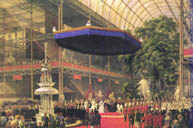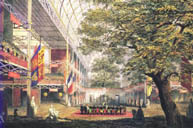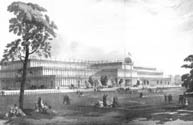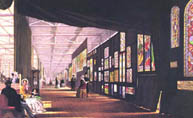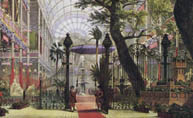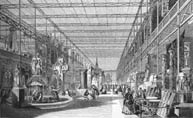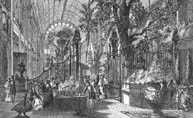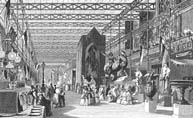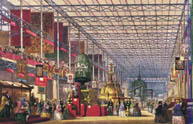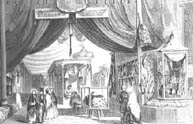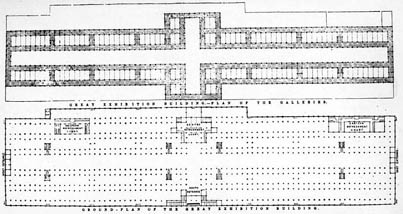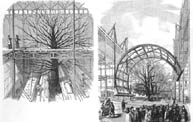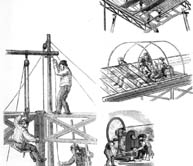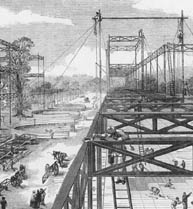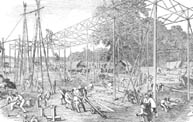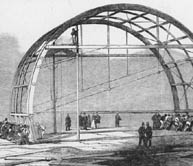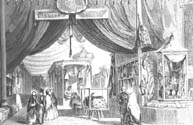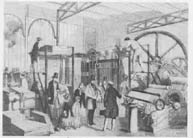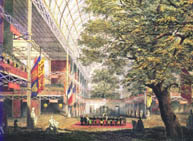Record keeper Henry Cole, Queen Victoria's husband Prince Albert, and the Duke of Devonshire's gardener, Joseph Paxton
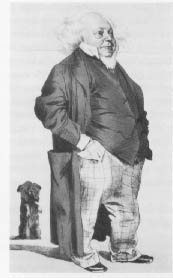
The exhibition emerged from the Society for the Encouragement of Arts, Manufactures, and Commerce.
The real driving force behind the Great Exhibition of 1851 was Henry Cole, an assistant-keeper at the Public Records Office. Cole helped organize the Records Office after fire had burned down the old Parliament buildings.
Cole had a wide range of interests including writing, editing and publishing books and journals. Under the pseudoname of Felix Summerly, Cole wrote books on art collections. He founded the Journal of Design to encourage artists to apply their talents to every day articles and to encourage manufacturers to mass produce them. Felix Summerly's Home Treasury publications covered a broad range from Children's books to the first Christmas card ever published.
In 1845 the Society of Arts' award for best design of tea service went to 'Felix Summerly'. Henry Cole received royalties on thousands of sets made by Messrs Minton of Stoke.
The Society elected Cole to their council in 1846 and a delegation including Cole went to Prince Albert to seek his support. Albert agreed to become President of the Society and in 1847 a royal charter was granted and it became the Royal Society for the Encouragement of Arts, Manufactures and Commerce.
Through efforts of Albert and Cole, a successful Exhibition of Art Manufactures was held in 1847. An enlarged version in 1848 and 1949 were all successful. Society representatives Cole, Fuller and Wyatt visited the 1949 11th quinquennial Paris Exhibition and was disappointed to find out from the French minister that foreign countries were not present. Already involved in planning the 1850, and 1851 Society of Arts exhibitions Cole saw a need for an international exhibition. New French processes like the Jacquard loom which was exhibited in Paris could be adapted later to other materials and Cole saw the need to make industry aware of progress elsewhere. After meeting Cole, Albert announces 'The Exhibition shall be a large one embracing foreign productions' and a Royal Commission is proclaimed to do this. Albert risks his reputation by backing this international exhibition. "It cannot fail to soften, if not eradicate altogether, the prejudices and animosities which have so long retarded the happiness of nations" dreams Albert as he talks of a peace-festival.
(quoted from 'Albert his life and work' by Hermione Hobhouse:)
"He put forward a vision of human progress:"
' ...we are living at a period of most wonderful transition, which tends rapidly to accomplish that great end, to which all history points - the realization of the unity of mankind. Not a unity which breaks down the limits and levels the peculiar characteristics of the different nations of the earth, but rather a unity, the result and product of those very national and antagonistic qualities.
The distances which separated the different nations... are rapidly vanishing before the achievements of modern invention, and we can traverse them with incredible ease; the languages of all nations are known... thought is communicated with the rapidity, even by the power of lightning. On the other hand, the great principle of division of labour, which may be called the moving power of civilisation, is being extended to all branches of science, industry and art...
... the publicity of the present day causes that no sooner is a discovery or invention made than it is already improved upon and surpassed by competing efforts. The products of all quarters of the globe are placed at our disposal and we have only to choose which is the best and cheapest for our purposes, and the powers of production are intrusted to the stimulus of competition and capital.
Gentlemen, the Exhibition of 1851 is to give us a true test and a living picture of the point of development at which the whole of mankind has arrived in this great task, and a new starting-point from which all nations will be able to direct their further exertions.'
From "Prince Albert's Speeches: 1862"
Cole had previously obtained permission to use the great courtyard of Somerset House for a series of triennial exhibitions starting in 1851. He also convinced the Board of Trade to strengthen copyrights so manufacturers would be more willing to exhibit their goods. Albert suggests that Somerset House is not large enough for this and that part of Hyde Park should be used instead. Permission is obtained with the support of the Duke of Wellington, the Hyde Park Ranger (a popular public figure since Napoleon's defeat).
The Royal commission sees nearly 250 submissions but none of them will be constructed in time or within a reasonable budget. The Royal commission undertakes to construct the building themselves, but the plan is a dubious one. Fate intervenes with Paxton visiting the new Parliament buildings to meet a fellow railroad director and friend Ellis. The acoustics being tested in the debating chamber were miserable, and Ellis commented on other mistakes made on the Charles Barry building design. Paxton comments if that is true then an even greater mistake was about to be made with the Great Exhibition designs, and offers some ideas of his own be put before the Royal Commission if it was not too late. Ellis runs Paxton over to the Board of Trade to offer his alternative suggestions to Cole who happens to be there. Within less than a fortnight Paxton promises to submit plans and a tender if a clause is introduced allowing alternate plan with tender. His design is not only promised to be erected quickly (time was running out), but (unlike most of the alternate solid brick designs) it was to be easily removed allowing Hyde Park to be restored to its previous state. Most of the materials were reused when a larger Crystal Palace was created at Sydenham.
Paxton, a gardener's son, was employed at age 23 as gardener by the 6th Duke of Devonshire. He become known as the designer of the Crystal Palace for which he was knighted. Later he became a member of Parliament.
But by 1850 Paxton was already established, having published many well known books on gardening. He refused an offer to be the Royal Gardener choosing to remain with 6th Duke of Devonshire. His cultivation of the Victoria Regia giant lily lead to the construction of the greenhouse at Chatsworth on which the Crystal Palace design is modelled. The structure of the giant lily inspired the design of the Chatsworth greenhouse and the derived Crystal Palace.
His daughter is pictured standing on a lily leaf illustrating its supporting strength. His experience there allowed him to do the plans in less than 10 days with the original design ideas drawn on a blotter. His organizational skills were well known to both Victoria and the Duke of Wellington, and their confidence in him helped bring this design to life. Having the Stephensons and other known industrialists as friends probably helped as well.

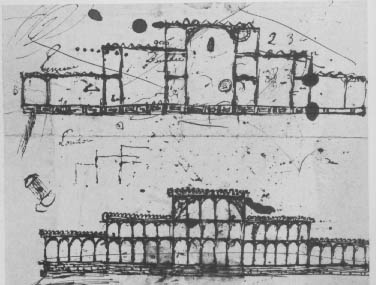
Paxton had already experimented with wood, cast iron and glass, and knew these materials well. The combination of pre fabricated components and site construction supervised by the firm of Fox and Henderson (contractors, engineers, and iron mongers from Birmingham) enabled Paxton, Fox and Henderson to deliver the Crystal Palace on time and without the loss of even 1 life. This building was several times larger than any building up to that point in time. 1848 by 408 feet, main building area including a transept that completely enclosed several mature elm trees.
Paxton did quite a bit of housing related work. He had earlier experimented on the use of sewage as a fertilizer. In Public Health area Paxton made designs for sanitariums providing covered spaces. Paxton visited most of the Hospitals in England. In moving some of the estate housing at Chatsworth, he designed cottages for Edensor which is considered a good model of estate housing.
Albert transformed a local exhibition into an international one. The legacy of the Great Exhibition of 1851, perhaps one of the few international exhibitions to ever make large amounts of money, still lives on today. Several great institutions were founded with the profits: including the Victoria and Albert Museum, Imperial College, etc. Scholarships which were setup and still continue reaped an immense contribution to the world's body of knowledge. Recipients include several Nobel prize winners: one scholarship went to Rutherford, a son of a New Zealand farmer.
Alfred was Chancellor of Cambridge University, during a time when non-anglicans were starting to be admitted to Oxford and Cambridge. Major curriculum reforms lead by Albert were passed by Cambridge Senate in 1849. Even before the closing in 1851, Albert suggested using the surplus for "an Establishment in which the application of Science and Art to industrial pursuits the Industry of all nations maybe raised in the scale of human Employment, and where by the constant interchange of Ideas, Experience and its results each nation may gain and contribute". The South Kensington project included Henry Cole who became superintendent of the Government Schools of Design in 1852. Materials from the 1851 exhibition were augmented by other industrial, scientific, and fine art collections. These collections were used for teaching materials and their access was extended to evening Openings so working men would attend lectures. Albert attended many of lectures personally.

The Royal College of Arts evolved from this project in 1897,In 1899, the South Kensington museum became the Victoria and Albert Museum and the scientific education part became Imperial College in 1907. The legacy of these institutions and the people that have passed through them lives on today as a great tribute to the ideas of these three men.
Housing the masses
Experimentation on improving housing for the poor was done by some societies. Cole numbered among his friends some of the great reformers of that era including John Stuart Mill, and Sir Edwin Chadwick who greatly improved sanitation in London. Cole encouraged manufacturers to mass produce domestic articles cheaply while maintaining quality.
Paxton's site assembly and use of prefabricated components is similar to Levitt's 1950's successful site construction projects.Organizing crews of workers to work efficiently is still a major factor between large profits and little or no profit, especially if there is a deadline to meet.
Albert supported and was president of several housing reform societies and they not only obtained his support but also his advice. He was president of the Society for Improving the Condition of the Labouring Classes in 1844. Their objective was to commission designs for affordable sanitary buildings for the working classes in large urban environments. Albert persuaded the Duke of Wellington to let it erect a pair of cottages at Hyde Park. Henry Roberts' model cottage design was erected in 1851 and viewed by many of the Exhibition visitors. One pair of cottages was moved to Kennington Park, another stands in Windsor erected by the Royal Windsor Improvement Society. Afterwards many of these were actually built and many more influenced by its design features including: water, internal sanitation, fresh air, and separate bedrooms for children. The Roberts' (two floor) design was even widely copied in America but with more floors. Robert's book on housing was translated into Foreign languages including French.
Quote from Early Victorian England Volume I, edited by G. M. Young:
"The Metropolitan Association for Improving the Dwellings of the Industrial Poor was founded in 1842, and the tenement for which Prince Albert received the Gold Medal Class VII at the Great Exhibition represents the highest point reached by housing science in our period. There are four flats in a block, with external staircase. Each has a lobby, a living- room with heating cupboard (150 sq.ft.); scullery with sink, rack, dustshaft and ventilator, meatsafe, and coal-bin; three bedrooms with external ventilation (one of 100 sq. ft., two of 50); a water-closet flushed from a cistern. They cost about £ 450 a flat and could be let at 3s. 6d. to 4s. Wherever these Model Dwellings rose, fever disappeared as by magic. But they could not rise fast enough. A rent of 4s. was only within the reach of a mechanic in good and regular work, and the slums which were one of the unsolved problems of early Victorian England remain an unsolved problem still."
(McGill's Minimum Cost Housing Group is actively working to solve this "unsolved problem"!)

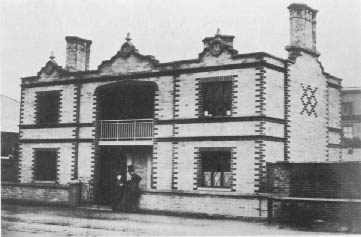
Self-improvement
A theme that Paxton and Cole both personify. Paxton authored several self improvement gardening books and was largely self taught himself. Albert often attended classes scheduled in evenings so working people could attend. Perhaps one should recall that the Exhibition Society's name suggests Encouragement explicitly and while many of today's organizations mean well, they forget the importance of self-improvement.
References:
Anthony Bird: Paxton's Palace
Art Journal Illustrated Catalog of the Exhibition of 1851
Asa Bridges: Iron Bridges to Crystal Palace
Cowper: 1852 detailed plans. Toronto Metro Reference copy
Christopher Hobhouse
Hobhouse Hermione: Prince Albert his life and Work
Her Majesty The Queen: Journal
Illustrated London News
Punch
Victoria and Albert Museum: The Great Exhibition of 1851
Summerly's Exhibition and Paxton's Crystal Palace
History of the Great Exhibition of 1851 (see above)
Prince Albert, Henry Cole and Joseph Paxton were the main people behind the Exhibition and largely responsible for its great success.
Opening of the Great 1851 Exhibition by Queen Victoria
The Opening of the Great Exhibition of 1851 was an event that, according to people who attended both, outshone Queen Victoria's coronation. This was the zenith of the British Empire and Britain's great exhibition (unlike France's previously) was international with foreign exhibits accounting for about half the exhibition space.
Queen Victoria's diary describes the opening and some of her visits to the Exhibition
The international aspect of the exhibition was displayed outside with various national flags flying from flag poles on the roof of the building for the duration the exhibition.
Outside views of the Paxton's Crystal Palace
Interior views of the Great Exhibition of 1851
Samples of the Exhibits
The construction of this huge building 1848 feet by 454 feet took only a few months from September 1850 to January of 1851. This feat was primarily accomplished by Joseph Paxton who designed the building, Fox and Henderson (contractors, engineers and ironmasters from Smethwick) and Chance Brothers glass makers from Birmingham. Paxton's design sketched on a blotter in less than two weeks was based primarily on an earlier greenhouse design Paxton used to house the giant Victoria Regia lily in Chatsworth. The structure of the lily, radial ribs strengthened by slender cross ribs, inspired the Chatsworth design. The solution in iron, wood and glass was lighter and cheaper than other designs submitted. The Parliament buildings designed by the architect Charles Barry had many problems and Paxton suggested he might have a better Exhibition solution. A series of circumstances rescued the Exhibition, Paxton's design was the only feasible one. Most of the other submissions would take too long and would not be completed in time. The dimensions of the building based on 24 foot intervals were a result of the maximum size of a sheet of glass that could be manufactured at a reasonable cost (49 inches was the cheapest for reliable 16 oz glass).
Mostly site construction using pre fabricated components, some of which were cast less than 24 hours earlier. The cast iron columns were tested on site, and on site milling and machine painting included miles of wood glazing bars.
Even temporary fencing material was designed to be used in the final building so little was wasted. The transept was strategically placed to preserve and temporarily cover the large elm trees on the site. When the building was torn down and moved to Sydenham, broken glass was remelted providing some of the replacements.
Paxton's greatest skill perhaps was his ability to coordinate his crews of workers. Earlier at Chatsworth 1843, he impressed both a young Victoria and the Duke of Wellington. They both wondered how the grounds were so proper the morning following an evening of celebration. Paxton had his crews working quietly at night using torches. His concern for his former workers extended into later years when the 7th Duke of Devonshire had to lay workers off, and Paxton tried to find them jobs elsewhere. Paxton's work on Edensor was a good model of a housing estate for workers.
Building of the Crystal Palace
Extracts from Queen Victoria's Diary
These extracts from Victoria's Diary have been printed in many places. "The Great Exhibition of 1851" printed by the Victoria and Albert Museum is an accurate reference.
Opening of the Great 1851 Exhibition by Queen Victoria
"May I This day is one of the greatest and most glorious days of our lives, with which to my pride and joy the name of my dearly beloved Albert is for ever associated!...
The Park presented a wonderful spectacle, crowds streaming through it - carriges and troops passing, quite like the Coronation and for me the same anxiety... At 1/2 past II the whole procession in 9 state carriges was set in motion...
I never saw Hyde Park look as it did, being filled with crowds as far as the eye could reach. A little rain fell, just as we started, but before we neared the Crystal Palace, the sun shone and gleamed upon the gigantic ediface, upon which the flags of every nation were flying...
In a few seconds we proceeded, Albert leading me, having Vicky at his hand and Bertie holding mine. The sight as we came to the centre where the steps and chair (on which I did not sit) was placed, facing the beautiful crystal fountain was magic and impressive. The tremendous cheering, the joy expressed in every face, the vastness of the building, with all its decorations and exhibits, the sound of the organ (with 200 instruments and 600 voices, which seemed nothing) and my beloved husband, the creator of this peace festival 'uniting the industry and art of all nations of the earth', all this was indeed moving, and a day to live for ever. God bless my dearest Albert, and my dear Country, which has shown itself so great to-day. One felt so grateful to the great God, whose blessing seemed to pervade the whole undertaking. After the National Anthem had been sung, Albert left my side and at the head of the Commissioners,- a curious assemblage of political and distinguished men- read the Report to me, which is a long one, and I read a short answer. After this the Archbishop of Cantebury offered up a short and appropriate prayer, followed by the singing of Handel's Hallelujah chorus, during which time the Chinese Mandarin* came forward and made his obseisance. This concluded, the Procession of great length began, which was beautifully arranged, the prescribed order being exactly adhered to. The Nave was full of people, which had not been intended, and deafening cheers and waving of hankerchiefs continued the whole time of our long walk from one end of the building to the other. Every face was bright and smiling, and many had tears in their eyes. Many Frenchmen called out 'Vive la Reine'. One could, of course, see nothing but what was high up in the Nave, and nothing in the Courts. The organs were but heard little, but the Military Band at one end had a very fine effect, playing the march from Athalie as we passed along. The old Duke of Wellington and Ld. Anglesey walked arm in arm, which was a touching sight. I saw many acquaintances amongst those present. We returned to our place and Albert told Ld. Breadalbane to declare the Exhibition to be opened, which he did in a loud voice saying 'Her Majesty commands me to declare this Exhibition open', when there was flourish of trumpets, followed by immense cheering. We then made our bow and left.
All these Commissioners and the Executive Committee etc. who had worked so hard and to whom such immense praise is due, seemed truly happy, and no one more so than Paxton, who may feel justly proud. He rose from an ordinary gardener's boy! Everyone was astounded and delighted.* The return was equally satisfactory, the crowd most enthusiastic, and perfect order kept. We reached the Palace at 20m. past I and I went out on the balcony, being loudly cheered. The Prince and Princess were quite delighted and impressed. That we felt happy and thankful, I need not say, proud of all that had passed and of my beloved's success. I was more impressed by the scene that I had witnessed than words can say. Dearest Albert's name is for ever immortalised, and the absurd reports of dangers of every kind and sort, put out by a set of people - the 'soi-disant' fashionables and the most violent protectionists, - are silenced. It is therefore doubly satisfactory that all should have gone off so well and without the slightest incident or mischief..."
*Notes: The 'Mandarin' imposter was actually a junk (Chinese ship) captain. Through Mrs. Paxton's dowry and investments, the Paxtons were by this time quite a wealthy family. They were the main founders (contributing 25,000 pounds) of a newspaper 'The Daily News' that employed Charles Dickens briefly as its editor.
"To the Exhibition" excerpts from Queen Victoria's journal
May 3 ...to the Crystal Palace, where Ld. Granville, Col. Reid, Mr. Mayne and other gentlemen connected with the Exhibition joined us...
We came back at 1/2 past II, much pleased and interested, for so much knowledge was imparted to me and the use of everything etc. etc. explained, so that one really got a good deal of information. It ought to do wonders in enlightening young people, both high and low...
May 5 ...and saw Sir G. Grey, who gave excellent reports of the state fo London, and that there had not been one accident on the 1st of May, nor one Police Report; and that it had been estimated that between 5 and 700,000 people had been assembled in the Park that day! Inside the building there were between 20 and 30,000. After the Council we saw Ld Grey who could not cease praising the Exhibition, its beauty and its usefulness in every sense of the word...
May 7 ...From here we crossed the Transept to where the Indian exhibits were placed. We were quite dazzled by the most splendid shawls and tissues. Next went to South Austrailia and New Zealand, where the exhibits consist chiefly of raw products- but very valuable ones, such as beautiful specimens of wood etc. Canad made an admirable show, fine furniture, pretty sledges, and a very good and novel kind of fire engine...
After this to Mr. Pugin's mediaeval room, full of church ornaments, beautiful mantel pieces etc...
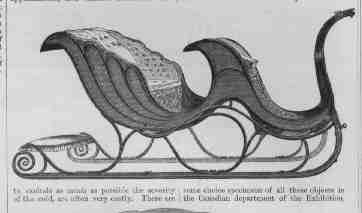
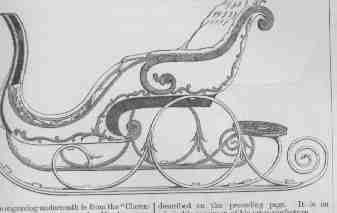
May 10 ...From here we made a very detailed inspection of Sheffield ware, beginning with a model of the process by which steel is made from iron and finishing with the most beautiful cutlery. There were 'Bowie' knives in profusion, made entirely for Americans, who never move without one...
Every time one visits this great work one feels more and more impressed with its lofty conception. The mottos of the Catalogue, chosen by my beloved Albert, are very appropriate and significant of the great undertaking, such as: 'The Earth is the Lord's and all that therein is'- 'Say not the discoveries we make are out own. The germs of every art are implanted within us, and God, our instructor, without our knowing it, develops the faculties of invention'- 'The progress of the human race resulting from the labour of all men ought to be the final object of the exertion of each individual. In promoting this end we are carrying out the will of the Great and Blessed God.' The latter motto is Albert's own...
May 12 ...We went through the sections of raw materials beautifully arranged: minerals, ores in all shapes, coal, copper, stone, marble, crystal, etc... Visted the locomotives...
May 19 ...1st visited the North German section, but meagrely represented owing to that foolish Protectionist feeling, which will do no one but themselves harm. Hamburg has many articles in horn, some pretty furniture, a large collection of sticks, handkerchiefs, embroideries etc. Next Russia... 3rd to America, ... a reaping machine etc. We crossed over and began going down the south side, which begins with America...
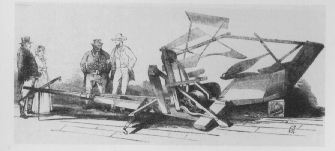
May 21 ...From France we went straight on to Turkey, the department of which is beautifully arranged, under a sort of tent, containing charming Turkish stuffs, including very fine silks, the manufacture of which was lately introduced by the Sultan into Turkey, raw materials, carpets and rugs, etc. very interesting...
May 30 ...Continued just where we left off yesterday, going past the chemical productions, which are very interesting, and the crystallization of all colours and sizes, really wonderful. Went round the staw hat manufactures and the Swiss section, where we remained some time, examining the really exquisite watches some very diminutive, barely an inch in circumference, most beautifully set with lovely enamelled exteriors of every kind and shape -one being on the top of a pencil case! The workmanship was most complicated and perfect...
June 2 ...After Breakfast to the Exhibition. Went through all the chemical productions, preserved fruits, flowers, milk, and meat of every sort; - through the very beautiful collection of grain of Lawson from Scotland- saw many, things made out of fibres of grass - dyed flowers- chocolate etc. At the end of that Gallery there is a very interesting collection of guns, muskets of every sort and kind...

June 7 ...To the Exhibition: went to the machinery part, where we remained 2 hours, and which is excessively interesting and instructive, and fills one with admiration for the greatness of man's mind, which can devise and carry out such wonderful inventions, contributing to the welfare and comfort of the whole world ...
June 11 ...To the Exhibition, with our relatives. We went first to look at the Russian exhibits, which have just arrived and are very fine: doors, chairs, a chimney piece, a piano, as well as vases in malachite, specimens of plate and some beautiful tasteful and very lightly set jewelry. Afterwards went to machinery...
Oct 15 ...At 10 Albert started for the ceremony of the Closing of the Exhibition, which was not be be in state. ... Albert was most enthusiastically received. Unfortunately it rained a little. Messrs. Dilke, Paxton (for whom this is indeed an immemse, though deserved distinction, and very striking as to the possibility fo the lowest being able, by their own merits, to rise to the highest grade of society, - he was only a gardener's boy), Mr. Cubitt, and Mr. Fox are to be knighted; Dr. Lyon Playfair, Mr. Cole and Sir Stafford Northcote to be Companions of Bath.




